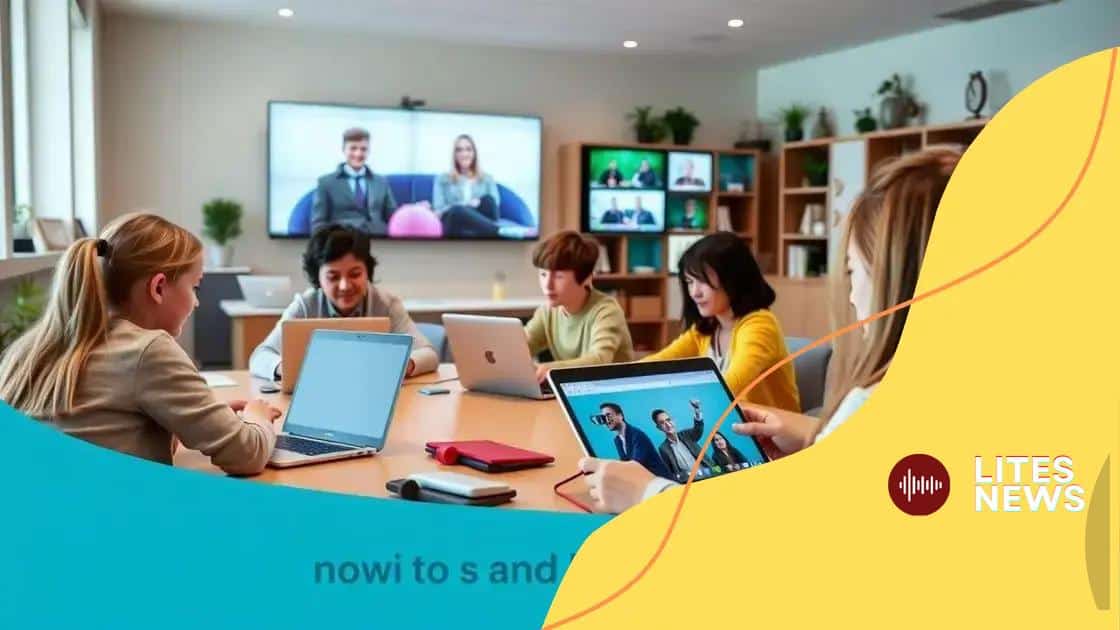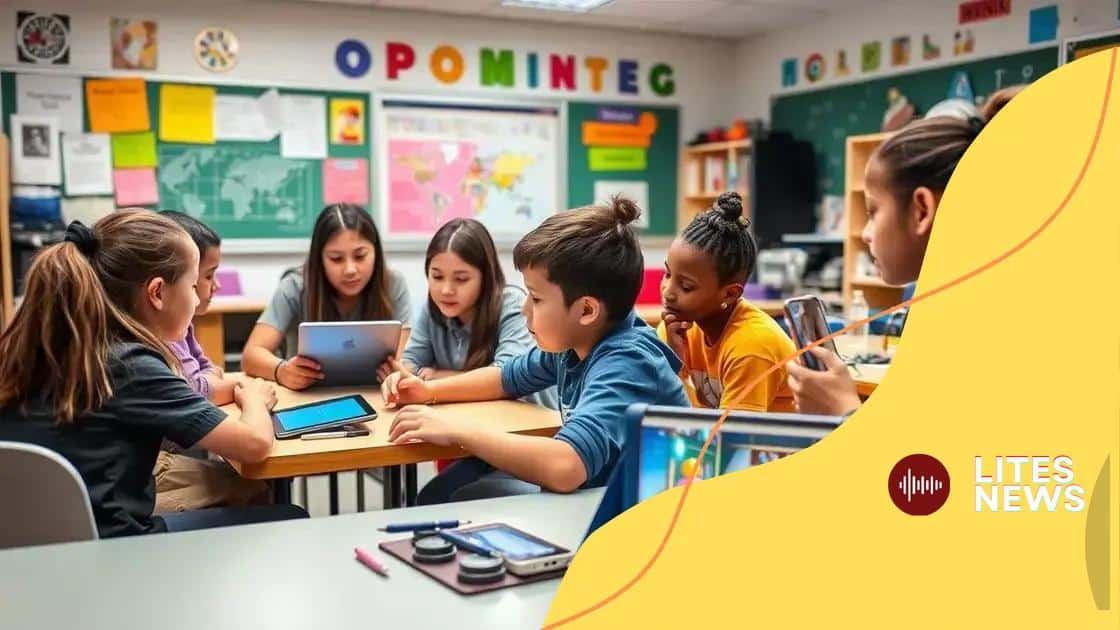Remote learning innovations that transform education

Remote learning innovations enhance education through personalized learning, technology integration, and flexible models while addressing challenges like accessibility and student engagement.
Remote learning innovations have taken educational institutions by storm, providing new ways for students to engage with content and interact with peers. Have you considered how these advancements could change the landscape of learning as we know it?
Understanding the impact of remote learning
Understanding the impact of remote learning is crucial as it shapes how students engage with education today. This new approach has opened doors for many, enhancing accessibility and flexibility in learning.
Remote learning allows students to connect from anywhere. This flexibility means they can learn at their own pace, fitting education around their lives.
Positive Effects of Remote Learning
One major advantage is the opportunity it provides for diverse learning experiences. Students can interact with peers from various backgrounds, enriching their education.
- Increased accessibility for students with disabilities
- Opportunities for personalized learning paths
- Availability of a wider range of resources
Additionally, remote learning encourages self-discipline and time management skills in students. They learn to take responsibility for their studies, fostering independence which can be vital in their future endeavors.
Challenges Faced in Remote Learning
However, some challenges persist with this new model. Issues such as technology access can create barriers for some students, affecting their ability to participate fully.
- Lack of access to reliable internet
- Difficulty in maintaining motivation
- Challenges in engaging with teachers and peers
Moreover, the absence of a physical classroom environment can lead to feelings of isolation. It becomes essential for educators to create engaging online experiences to tackle these issues effectively.
With the right support and resources, the challenges of remote learning can be overcome. Understanding both the benefits and drawbacks is the key to making this model work for everyone.
Key technologies driving remote education
Key technologies driving remote education have transformed how students learn today. With the rise of digital tools, education has become more accessible than ever.
At the forefront of this change are learning management systems (LMS). These platforms enable teachers to organize course materials and streamline communication with students.
Popular Learning Management Systems
Many schools and universities utilize various LMS to enhance the learning experience. Some popular options include:
- Moodle
- Canvas
- Blackboard
- Google Classroom
These systems offer features such as trackable assignments, grades, and resources, allowing students to stay organized and engaged with their coursework.
Interactive Tools and Resources
Another key technology is interactive tools like video conferencing software. Programs such as Zoom and Microsoft Teams allow students and teachers to connect in real-time.
This dynamic interaction creates a classroom atmosphere, even from a distance. Students can participate actively, asking questions and collaborating with peers in a virtual setting.
Additionally, educational apps and online resources further enrich the learning journey. With access to online libraries, simulations, and interactive lessons, students can explore topics in depth.
- Khan Academy for self-paced learning
- Quizlet for engaging study methods
- EdPuzzle for interactive video lessons
Overall, these technologies make learning more engaging, fostering a sense of community among students. As education continues to evolve, embracing these innovations is essential for creating effective remote learning environments.
Benefits of innovative teaching methods

Benefits of innovative teaching methods are becoming clear as schools adapt to new learning environments. These methodologies not only enhance student engagement but also improve learning outcomes.
One significant advantage is the ability to meet diverse learning styles. Every student learns differently; innovative teaching methods allow educators to tailor their approaches to fit individual needs.
Engagement and Motivation
Using modern techniques, such as project-based learning and gamification, can make lessons more exciting. This innovation fosters greater motivation among students, encouraging active participation.
- Project-based learning promotes teamwork and problem-solving skills.
- Gamification adds elements of competition and rewards, which can increase interest in subjects.
- Flipped classrooms allow students to preview lessons at home, engaging them more during in-class activities.
These strategies create a dynamic learning environment, where students feel empowered to take charge of their education. Additionally, technology integration enhances these methods, making lessons more interactive.
Critical Thinking and Collaboration
Another benefit of innovative teaching is the promotion of critical thinking. By encouraging students to explore and question concepts, educators help them develop necessary skills for real-world applications.
Collaborative projects enable students to work together, sharing ideas and learning from one another. This helps build communication skills, essential for future careers.
Furthermore, innovative methods encourage creativity. When students are allowed to express their ideas freely, they become more invested in their learning. This increased investment often leads to better retention of knowledge and a deeper understanding of the material.
Incorporating these innovative approaches into teaching does not only create better learners but also prepares students for success in a rapidly changing world.
Challenges faced in remote learning
Challenges faced in remote learning are critical to address as they can greatly affect students’ educational experiences. While remote learning offers many benefits, it also brings unique obstacles.
One major challenge is the lack of access to reliable technology. Many students do not have a consistent internet connection or the necessary devices to participate effectively.
Technology Barriers
For those struggling with technology, participation can be tough. Schools are working to provide resources, but gaps still exist.
- Frequent internet outages disrupt learning sessions.
- Limited access to laptops or tablets makes it hard to complete assignments.
- Some students lack digital literacy skills necessary for online learning.
In addition to technology issues, students can experience feelings of isolation. Without physical interaction, many miss the social aspects of school life.
Motivation and Engagement
This isolation can lead to decreased motivation. Many students find it challenging to stay engaged during online classes, especially when distractions are present at home.
Time management also becomes an obstacle. Students must develop self-discipline to balance schoolwork while navigating home responsibilities.
Moreover, some educators may struggle to adapt their teaching styles for a virtual format, making lessons less effective. They need support and training to create engaging online content.
All of these factors contribute to a learning environment that can be less effective than traditional classrooms. Addressing these challenges is crucial to ensure students receive a quality education, regardless of the format they are in.
Future trends in digital education
Future trends in digital education promise to shape the way we learn in exciting ways. As technology continues to advance, schools are adapting to new tools and methods that enhance learning experiences.
One trend is the rise of personalized learning. With data analytics, educators can tailor lessons to fit individual student needs, making learning more effective and engaging.
The Role of Artificial Intelligence
Artificial intelligence (AI) is playing a significant role in this transformation. AI can analyze students’ progress and suggest resources suited to their learning styles.
- AI tutors provide additional support outside classroom hours.
- Adaptive learning programs adjust in real-time to student performance.
- AI can automate administrative tasks, allowing teachers to focus more on instruction.
Another trend is the shift toward hybrid learning models. Combining in-person and online learning allows greater flexibility for students. This approach caters to diverse learning preferences and can help maintain engagement.
Increased Focus on Digital Skills
As the job market evolves, digital literacy is becoming increasingly important. Schools are emphasizing the development of essential skills such as coding, digital communication, and online collaboration.
Additionally, virtual and augmented reality (VR and AR) are emerging tools that can enrich the educational experience. These technologies create immersive learning environments that captivate students’ attention.
Implementing these innovations will require training for educators. As teachers become more familiar with new technologies, they can better prepare students for the future job market.
Ultimately, the future of digital education is bright. By embracing these trends, we can create dynamic learning environments that empower students and prepare them for success in a rapidly changing world.
In summary, remote learning innovations are reshaping education and presenting both opportunities and challenges. By embracing advanced technologies and innovative teaching methods, we can create a more engaging and inclusive learning environment for students. However, it is essential to address the challenges, such as accessibility and motivation. As we move forward, focusing on these issues will be key to ensuring all students thrive in this new digital landscape.
FAQ – Frequently Asked Questions about Remote Learning Innovations
What are the main benefits of remote learning innovations?
The benefits include increased accessibility, flexibility in learning schedules, and opportunities for personalized learning tailored to student needs.
What challenges do students face in remote learning environments?
Students often struggle with technology access, feelings of isolation, and maintaining motivation while learning from home.
How can technology enhance remote education?
Technologies like learning management systems, AI tools, and interactive resources improve engagement and streamline communication between students and teachers.
What is the future of digital education?
The future includes trends such as personalized learning, the use of AI, hybrid learning models, and a focus on developing digital skills essential for the workforce.





